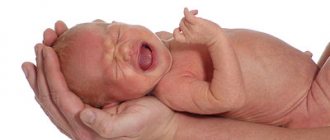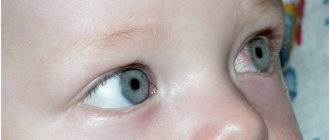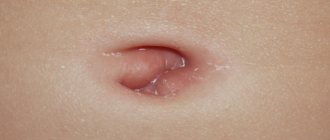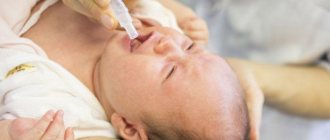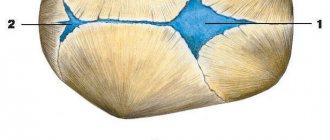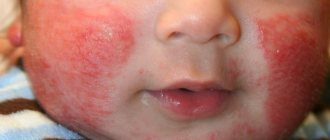Hello, my dear readers! It turns out that umbilical hernia in newborns is not that uncommon. It happens in 20% of cases. Much more than adults.
Moreover, if the child is premature, then the probability increases to 30%. Often suspicious symptoms appear during crying.
In this case, you need to seek help from a pediatrician. Let's figure out what a hernia looks like and what can be done at home.
Features of a hernia
Before deciding how to remove such a defect, let's find out how to correctly identify it. An umbilical hernia is a round bulge in the navel area in newborns.
Through the umbilical cord, the baby receives nutrition in the prenatal period, and when he is born, the need for it disappears.
Within a month, the navel ring should tighten and the vessels should close.
If this does not happen, then parts of the abdominal cavity and internal organs begin to protrude through the hole.
Moreover, if you press a little on the bulge, it will disappear. The size of the swelling depends on the umbilical ring. The problem is usually diagnosed by a pediatrician who feels the navel area during an examination.
At the same time, the dimensions of the umbilical ring and its edge are also determined. You can see what such a bulge looks like in the photo.
Symptoms
The main symptom of the disease is a protrusion in the groin area. In the inguinal-scrotal form, the formation occurs in the scrotum. The bulge becomes more pronounced when the baby cries and screams excessively and experiences excessive stress. When straining, intracavitary pressure increases, which forces organs into the processus vaginalis.
Undeveloped protrusions feel soft and elastic to the touch. The formation can be adjusted without any problems by simply clicking on it.
When reduced, the protrusion produces a rumbling sound if there are segments of intestine in it. During the adjustment, the baby does not experience discomfort.
How to determine an umbilical hernia in a baby?
After childbirth, all children have a weakened and not overgrown ring. But for many, this condition goes away within a month.
In other cases, a diagnosis is made and the necessary treatment is prescribed. In some babies, this bulge is visible to the naked eye. Here are the symptoms to be aware of:
- protrusion of the umbilical ring, which is easily set back, and its diameter can be in the range of 1-10 cm;
- in a relaxed state, the pathology is not particularly noticeable, but if the abdominal wall is tense, the disease may return again;
- the baby shows anxiety and weather dependence;
- Usually the swelling does not hurt, but with this illness, flatulence may occur.
If pain, weakness, vomiting and nausea are added to the main symptoms, this indicates a complication of the hernia.
At the same time, feces accumulate inside the intestines. These signs indicate a complex condition, so you should urgently consult a doctor.
Externally, the navel has an increased size, and when pressed, gurgling may appear. If the situation is advanced, then ultrasound, radiography and herniography .
Over time, the hernia may become larger.
Causes of formation in newborns
Let's look at the causes of this disease. Most often, this occurs due to the presence of anatomically weak tissue in the navel area.
It is also worth noting the following influencing factors:
- Low birth weight.
- Premature birth.
- Hereditary predisposition.
- Intra-abdominal pressure may be increased by coughing, constipation, and crying.
- Weak muscle tone.
- Boys have this problem less often than girls.
Parents should not allow their child to cry for a long time. At the first symptoms of protrusion, treatment should be carried out.
By the way, many parents believe that a similar problem occurs when the umbilical cord is tied incorrectly at birth. But this is a misconception.
When to see a doctor?
Immediately, as soon as they saw the bulging. It is unknown what caused it. Consequences can be avoided by timely diagnosis and correct prescriptions. If it is a hernia, pinching may occur. And this is a threat of necrosis, intestinal obstruction and other terrible things.
Well, these are already serious consequences that do not arise out of nowhere. All this is preceded by:
- Redness of the peri-umbilical area.
- Pus and other discharge.
- Frequent constipation and gas formation in the baby, which cannot be treated with conventional remedies.
Be sure to consult with specialists if you notice such symptoms. Only they can determine the cause and prescribe ways to combat it.
And now I'm waiting for your comments! Tell us why your little one's belly button sticks out? What is the diagnosis? What are you doing? Are there any first results? I also invite you to subscribe to blog updates to keep abreast of all new topics! Until next time. Bye!
Is it possible to cure
Now let's find out how to treat such ailment. The necessary therapy is prescribed only by the attending physician. In difficult cases, surgery may be prescribed.
If the pathology does not manifest itself strongly, then a bandage, patch or massage is used. If suddenly the hernia becomes pinched, then it is necessary to urgently go to the hospital. This condition is very dangerous, since the internal organs in the umbilical ring become blocked.
In this case, the blood vessels may become under pressure and blood will not flow into them. This condition is quite rare.
Effective massage
Massage is particularly effective; you can watch the video on how to do it. All movements should be light and without physical exertion. Pressure can be done as follows:
- clockwise and counterclockwise;
- along the oblique muscles.
The movements can be supplemented by rubbing the surface of the abdomen and pinching around the umbilical ring. In this case, you need to perform soothing strokes. Children's massage should be done in any case, regardless of illness. 4 weeks after birth, when the umbilical wound has healed, you can begin the necessary treatment. Massage should be done in the absence of inflammatory processes in the abdominal area. Here are some rules for its implementation:
- The procedure should be carried out in a warm room.
- Massage should begin half an hour before feeding.
- Up to two procedures can be performed per day.
- Only a specialist or parents who have been trained can perform the procedure.
- The baby should only be placed on hard surfaces.
Here is an option for children under three years old:
- First, stroking movements are performed clockwise up to 7 times.
- Massage from the navel to the sides along the oblique muscles with light pressure.
- Stroking from top to bottom. Do 5 reps.
- Rubbing the muscles from the sides towards the navel.
- Pressing the index finger around the navel.
- Circular movements around the bulge.
With such movements, the muscles contract and the tissue around the umbilical area strengthens. In addition, you can do bicycle exercises, swinging on a ball and squats. After two years of age, a hernia usually appears as a result of coughing, muscle wasting, and constipation. In this case, it is recommended to go with the child to the pool, attend physiotherapeutic procedures and get a massage.
What should parents do?
If any hernia is detected in a child, you should remain calm and be able to sensibly assess the situation. Most hernias, with the exception of spinal hernias, are successfully treated, and some in children of the first year of life go away on their own by the age of one and a half years.
If we are talking about common abdominal hernias (inguinal, umbilical, midline of the abdomen, femoral), then it is important to ensure that the child does not cry for a long time, since this provokes an increase in the size of the hernia. It is important to avoid respiratory diseases that occur with a strong cough. Regular massage, light exercises, and wearing a special orthopedic bandage will definitely benefit the baby. But there is no need to overfeed a baby with a hernia, so as not to cause indigestion or constipation.
You should remember the signs of a strangulated hernia as best as possible, because this can happen at any time:
- strong pain;
- vomiting, nausea;
- paleness of the skin;
- the hernia looks swollen, tense, and cannot be reduced.
At the first similar symptoms, parents should urgently take the child to a surgical hospital or call an ambulance, which will do this.
Useful exercises
Do you know that even small children can do exercises that will be an excellent preventive measure against hernia:
- You need to scatter toys around the child so that he squats, collects them and squats again.
- When the baby is lying on his back. Bring a toy to him so that he reaches for it. This will tighten your abdominal muscles.
- Hold your baby under your arms and encourage him to squat.
Laying on the tummy
Placing on the tummy is also used. Prevention and therapy in newborns can be practiced using this well-known method.
Pediatricians advise placing children on a hard surface for one to four minutes. In this position, the child demonstrates mobility of all parts of the body.
At the same time, gases are removed remarkably. Regular exercise strengthens the muscles of the abdominal wall.
Development mechanism
The processus vaginalis forms in the fetus at 12 weeks of gestation. This element of the peritoneum protrudes into the groin. Its main purpose is to move the testicles from the abdominal cavity to the scrotum. When the testicles descend into place, the process tightens. If the overgrowing process is disrupted, there is a risk of formation:
- hernial bulges,
- dropsy of the testicles,
- spermatic cord cysts.
When strands of the omentum and intestinal loops penetrate into the process, an inguinal hernia is formed in newborn boys. Symptoms of the pathology are determined by the fact that the vaginal process takes on the functions of a hernial sac, behind which is the spermatic cord and its elements.
If a hernia is detected in the groin, parents should show the baby to a doctor. Surgical treatment is not delayed for long; it is done after confirmation of the diagnosis.
An exception is children under six months old with serious illnesses and with a freely reducible bulge.
In this case, the operation is postponed until the child is 6 months old. Before surgery, he is under medical supervision. Relatives monitor manifestations of pathology. If a strangulation occurs, the baby needs emergency surgery.
Traditional methods
Sometimes treatment with folk remedies is also used. For example, our grandmothers used a conspiracy. Our ancestors believed that this disorder occurs in a child due to the influence of evil forces.
The technology is like this:
After giving birth to children, the mother should slightly squeeze the bulge in her tummy and say the following words: “Disease, I am gnawing at you, you have only one fang, and I have all 7, I will remove you.” The plot should be read three times.
Whether you believe such methods or not is up to you, but I prefer to consult a specialist.
Alternative Treatment
It is impossible to eliminate hernias in the groin using traditional methods of treatment. The child does not recover from spells and “poultices”. Traditional methods delay the operation, which complicates its implementation in the future due to the formation of compactions in the connective tissue.
Adhesions clog the vas deferens in boys, robbing him of his reproductive ability. For a long time, believing in conspiracies and miraculous remedies of healers, parents miss precious time. The baby is transferred to the hands of experienced doctors when irreversible and severe complications have developed.
Traditional healers know very well that an inguinal hernia “will not conspire” and will not disappear on its own. Until a certain time, they take advantage of the anatomical features of the hernial protrusion.
They reduce uncomplicated protrusions and hope that they will close by 3-5 years (this is possible for an umbilical hernia, but not for an inguinal hernia). By relying on healers, relatives lose not only money, but also the health of the baby, and possibly his life.
You should not believe in myths, especially in critical situations.
other methods
A special hernia bandage is also used. Or you can buy a special bandage, its price depends on the specific manufacturer.
It is put on in the morning. In this case, the hernia goes back into the abdominal cavity. It is also worth trying a special adhesive plaster. They need to seal the bulge. This procedure must be performed by a doctor, as it is used for 10 days. Treatment with a patch is performed as follows:
1. Prepare a piece of plaster 4-6 cm. If the baby is more than two years old, then its size should be 5-7 cm. 2. Roll a cotton ball. 3. Place your baby on his back and straighten his legs. 4. Place the bulge into the navel ring. Place a cotton ball on top. 5. Take 2-3 cm of leather from both sides and connect them together. This should create a fold along the abdomen. 6. Glue the prepared patch across it. The sticker must not be touched until it falls off. You can even bathe your baby with it.



